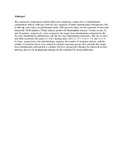| dc.description.abstract | We conducted a randomized double-blind trial comparing a single dose of trimethoprim-sulfametrole (640 to 3200 mg) with five-day regimens of either trimethoprim-sulfametrole (160 to 800 mg twice daily) or trimethoprim alone (200 mg twice daily) for the treatment of men with chancroid. Of 95 patients, 78 had cultures positive for Hemophilus ducreyi. Twenty-seven, 23, and 28 patients, respectively, were assigned to the single-dose trimethoprim-sulfametrole, the five-day trimethoprim-sulfametrole, and the five-day trimethoprim treatments. The rate of ulcer and bubo resolution, the mean (+/- S.D.) healing times (10.3 +/- 5.7, 11.0 +/- 7.4, and 11.9 +/- 8.2 days, respectively), the microbiologic response, the number of treatment failures, and the number of recurrent ulcers were similar in all three treatment groups. We conclude that single-dose trimethoprim-sulfametrole is a highly effective, inexpensive therapy for chancroid in men and may prove to be an important strategy for the control of H. ducreyi infection. | en |

